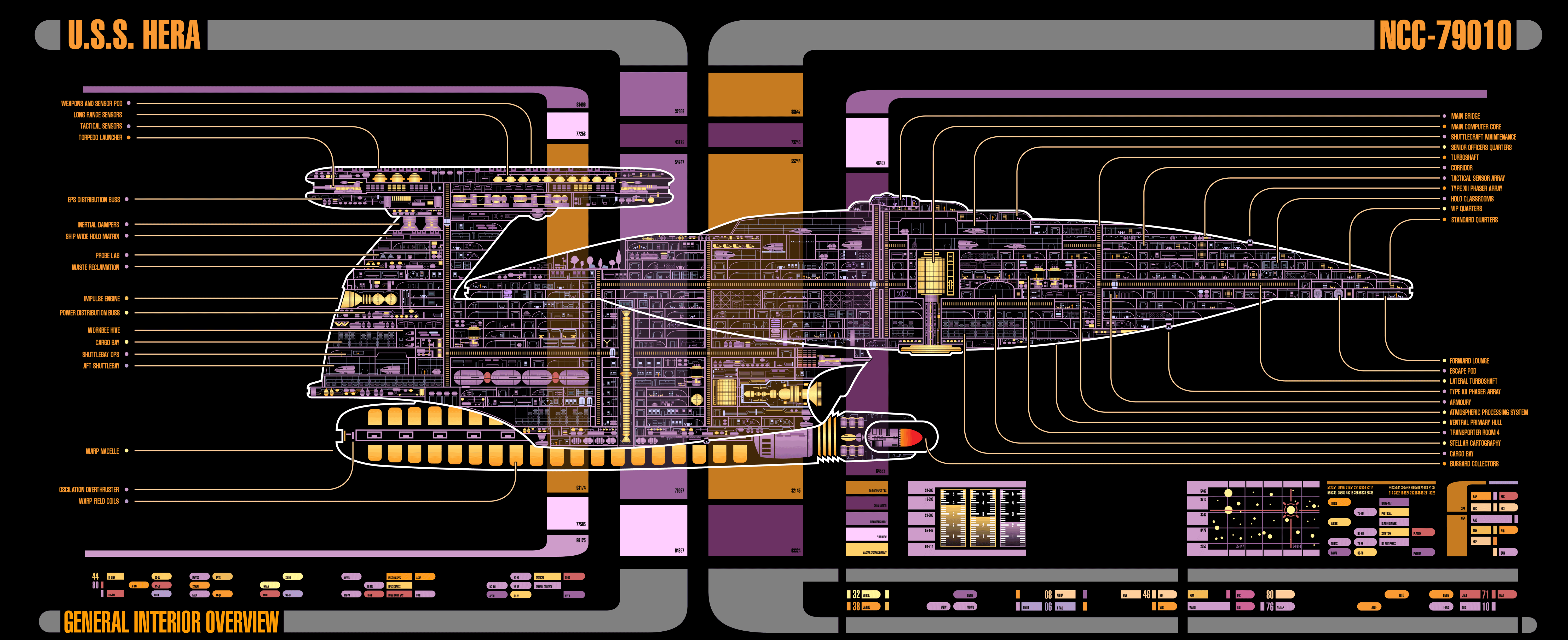Sidebar
Table of Contents
Nebula-class Starship
Overview
In the year 2343 the design for the all new multi-mission Nebula-class starship was approved. Construction of the Nebula-class was spearheaded under the authority of the Yoyodyne Division, with the prototype entering service in 2355.
The Nebula-class was designed from the outset to be a versatile ship, from performing various scientific and exploratory roles to conducting patrol and transport duties. The Nebula-class shared a similar design lineage with its larger Galaxy-class counterpart, notably its primary hull, secondary hull and nacelles. Compared to the Galaxy-class the Nebula has a more compact shape. The The Nebula-class was composed of two hull sections; the saucer-shaped primary hull mounted atop the secondary hull, with two warp nacelles mounted on either side of the secondary hull, directly below the primary hull.
Atop the primary hull, though connected to the secondary hull, was a superstructure which could support a variety of mission pods including a sensor pod, an enhanced tactical pod, a colony transport pod, an emergency field hospital unit, or additional warp nacelles. Although the basic Nebula design has approximately 80% of the capability of a Galaxy-class vessel in most areas, the addition of the mission pod brings that figure up to 95% or more in that specific area. This flexibility actually allows the Nebula design to accomplish almost identical missions despite its smaller size.
In service the Nebula-class has proved highly satisfactory, and in many ways these ships form the backbone of Starfleet's exploratory and scientific programs. Like the Galaxy-class they have received regular upgrades to their systems, most notably a new warp core design. With the advent of the threats from the Romulan Star Empire, Dominion and Borg, Starfleet invested in 67 new enhanced tactical pods for the Nebula-class, and sadly in recent years most of the class have carried this as the default loadout.
Mission Pods
The Nebula-class is well-known for being a test bed of modular components that would later be integrated, on a smaller scale, into the Danube-class runabout design. The vessel's upper outboard structures vary from vessel to vessel. Whilst several configurations had been fielded by the 2380s, during aftermath of the Dominion War the most common variant was the tactical configuration. In order to exchange pods, the ship must be docked at a certified facility for a minimum of two days in order to give sufficient time to perform diagnostics on all connections and systems. Many of the modules listed below contain habitable decks, and are referred to by letters; Deck A would be the top-most deck, Deck B would be below it, and so on.
Advanced Sensor Pod
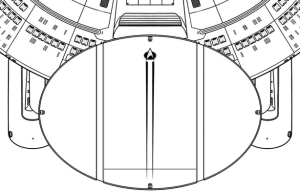 At first the majority of Nebula-class ships were outfitted with this pod, which greatly extended the ship’s sensor range, acuity and scan depth. With this pod the Nebula-class ship is matched only by the Nova-class surveyors in regards to sensor capability. Ships with this pod module were routinely assigned to deep-space exploration or long-range reconnaissance.
At first the majority of Nebula-class ships were outfitted with this pod, which greatly extended the ship’s sensor range, acuity and scan depth. With this pod the Nebula-class ship is matched only by the Nova-class surveyors in regards to sensor capability. Ships with this pod module were routinely assigned to deep-space exploration or long-range reconnaissance.
Cargo Pod
A reinforced pod with two large decks and several external access points, this module can be used when the capacity of the Nebula's 5 cargo bays is insufficient. Only a handful of these pods were constructed, but they did see service during the Dominion War to shift supplies from core systems to forward operating bases where they would once again be replaced by a tactical pod.
Carrier Pod
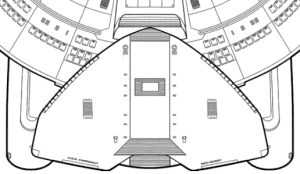 This module features a through-deck design that is utilized as a large hangar bay, effectively converting the Nebula into a carrier variant. An additional flight operations control tower is also featured. Whilst the pod could theoretically be used to house an additional complement of shuttlecraft, during the Dominion War the module was primarily used to stage fighter squadrons.
This module features a through-deck design that is utilized as a large hangar bay, effectively converting the Nebula into a carrier variant. An additional flight operations control tower is also featured. Whilst the pod could theoretically be used to house an additional complement of shuttlecraft, during the Dominion War the module was primarily used to stage fighter squadrons.
Colony Pod
The colony pod simply features additional quarters at the same standard as those provided for enlisted Starfleet personnel. Whilst the colony pod and the Nebula's inherent cargo capacity are insufficient on their own to colonize a new world, they make a useful addition to a colony convoy or as a follow-up trip.
Medical Pod
The handful of medical pods constructed featured advanced hospital facilities, additional transporter rooms and quarters to support a large number of medical staff and their patients. However, with the fleet of Olympic-class ships generally being under-deployed these pods have rarely seen service, even in the Dominion War.
Tactical Pod
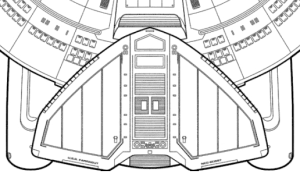 This design combines the tactical scanning elements of the advanced sensor pod with the offensive capabilities of a weapons pod. Following the Borg invasions and Dominion War, Starfleet quickly mobilized to deploy the tactical pod, which contains 6 forward-facing & 2 rear-facing torpedo launchers, as well as 3 Type X point-defense phaser emitters. The launchers are fed by an additional 125 photon torpedoes stored in the pod itself. While equipped with eight launchers, each launcher is a smaller type similar to that used by Intrepid-class ships, and as such can only fire up to 3 torpedoes at once, with a reload time of 6 seconds. Later versions of the pod are also equipped with a limited number of quantum torpedoes. The weapons pod is also equipped with two shield generators (one main, one backup), since it was realized that the pod would be an easy target. The shield generators are the same type used throughout the rest of the ship, and draw power directly from the auxiliary energy reserves during Red Alert situations. The tactical pod contains less torpedo storage than the original design in order to make room for the sensor pallets. Additionally, as the scanners are primarily designed to aid in targeting for the torpedoes and phasers they are not optimised for long-range use.
This design combines the tactical scanning elements of the advanced sensor pod with the offensive capabilities of a weapons pod. Following the Borg invasions and Dominion War, Starfleet quickly mobilized to deploy the tactical pod, which contains 6 forward-facing & 2 rear-facing torpedo launchers, as well as 3 Type X point-defense phaser emitters. The launchers are fed by an additional 125 photon torpedoes stored in the pod itself. While equipped with eight launchers, each launcher is a smaller type similar to that used by Intrepid-class ships, and as such can only fire up to 3 torpedoes at once, with a reload time of 6 seconds. Later versions of the pod are also equipped with a limited number of quantum torpedoes. The weapons pod is also equipped with two shield generators (one main, one backup), since it was realized that the pod would be an easy target. The shield generators are the same type used throughout the rest of the ship, and draw power directly from the auxiliary energy reserves during Red Alert situations. The tactical pod contains less torpedo storage than the original design in order to make room for the sensor pallets. Additionally, as the scanners are primarily designed to aid in targeting for the torpedoes and phasers they are not optimised for long-range use.
Warp Pod
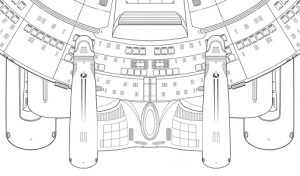 This type of pod is still considered experimental, and most likely will not be approved for fleet-wide use. The design features two nacelles, each approximately one-third scale, positioned directly above the main nacelles. While not giving the ship a higher warp speed, it does allow the ship to maintain high warp for a longer period of time. Given the amount of work that must be put into properly connecting the mini-nacelles, they are likely to remain in the experimental phase for some time. At this time, only four Nebula-class starships are equipped with this ‘module’.
This type of pod is still considered experimental, and most likely will not be approved for fleet-wide use. The design features two nacelles, each approximately one-third scale, positioned directly above the main nacelles. While not giving the ship a higher warp speed, it does allow the ship to maintain high warp for a longer period of time. Given the amount of work that must be put into properly connecting the mini-nacelles, they are likely to remain in the experimental phase for some time. At this time, only four Nebula-class starships are equipped with this ‘module’.
Weapons Pod
With the recent Borg invasions and Dominion war, Starfleet quickly mobilised to deploy the weapons pod, which contains 8 forward-facing pulse fire torpedo launchers and 3 additional type X phaser banks. The launchers are fed by an additional 200 photon torpedoes stored in the pod itself. The weapons pod is also equipped with two shield generators (one main, one backup), since it was realized that the pod would be an easy target. The shield generators are the same type used through-out the rest of the ship, and draw power directly from the auxiliary energy reserves during red alert situations.
Specifications
Class Information
- Expected Duration: 100 years
- Resupply Interval: 3 years
- Refit Interval: 10 years
- Role: Heavy Cruiser
Dimensions
- Length: 442.23 meters
- Beam: 453 meters
- Height: 130.43 meters
- Decks: 34 (+ additional in pods)
Warp rating
- Cruising Speed: Warp 6
- Maximum Speed: Warp 9.1
- Emergency Speed: Warp 9.6 for 12 hours
Personnel
- Crew: 735
- Officers: 130
- Enlisted: 550
- Marines: 25
- Civilians: 30
Auxiliary Craft
- Shuttlebays: 2
- Shuttles: 10
- Type-8 Shuttle: 2
- Type-9 Shuttle: 4
- Type-11 Shuttle: 2
- Type-18 Shuttlepod: 2
- Runabouts: 4
- Danube-class Runabout: 4
- Fighters: 0 (without Carrier Pod)
- Workbees: 6
Tactical Systems
- Energy Weapons: 8 Type-X Phaser arrays
- Torpedo Launchers:
- 1 forward
- 1 aft
- Torpedo Loadout:
- 100 quantum torpedoes
- 200 photon torpedoes
- 4 Tri-cobalt torpedoes
- Shields: Multi-Layered Shielding System
- Other Systems:
- Durantium/Tritanium double hull
Deck Listing
Sub-deck A
- pod tactical sensor systems
Sub-deck B
- sensor sub-systems
- forward torpedo launchers
- aft torpedo launcher
- torpedo loading mechanisms
Sub-deck C
- torpedo storage
- torpedo maintenance bay
Sub-deck D
- sensor sub-systems
- pod access
Deck 1
- Captain's ready room
- main bridge
- observation lounge
- Executive Officer's office
Deck 2
- junior officers' quarters
- environmental system controls
Deck 3
- junior officers' quarters
- flight control center
- primary sensor array
Deck 4
- main shuttle bay
- upper shuttle maintenance bay
- shuttle bay operations
Deck 5
- lower shuttle maintenance bay
- VIP quarters
- primary communications array
Deck 6
- transporter rooms 1-4
- main science labs 1-10
- Chief Science Officer's office
Deck 7
- senior officers' quarters
- hydroponics bay
- auxiliary deflector control
Deck 8
- crew quarters
- Commanding Officer's quarters
- Executive Officer's quarters
- VIP quarters
Deck 9
- senior officers' quarters
- stellar cartography
- officers' mess
Deck 10
- ten forward lounge
- stellar cartography (lower bay)
- fusion reactors 1-4
- saucer impulse engines
- main computer core (level 1)
Deck 11
- holodecks 1-4
- gymnasiums 1 & 2
- banquet halls
- security office
- brig
- main computer core (level 2)
Deck 12
- main sickbay
- sickbay main computer
- surgical ward
- neo-natal ward
- biohazard ward
- critical triage ward
- primary ICU
- overflow ICU
- trauma stasis unit
- medical sciences ward
- Chief Medical Officer's office
- Counsellor's office
- main computer core (level 3)
Deck 13
- cargo bays 1 & 2
- residential quarters
- primary IDF generators
Deck 14
- cargo bay 3 & 4
- cargo loading doors
- residential quarters
Deck 15
- Marine facilities
- armoury
- maintenance bay 1
Deck 16
- Captain's yacht docking port
- secondary communications array
Deck 17
- crew quarters
- upper mess decks
- tactical sub-systems
Deck 18
- crew quarters
- auxiliary IDF generators
- sensor maintenance
Deck 19
- crew quarters
- lateral sensor arrays
- secondary computer core (upper level)
Deck 20
- crew quarters
- lower mess decks
- sensor sub-systems
- secondary computer core (lower level)
Deck 21
- holodecks 5 & 6
- deuterium storage
- main probe storage
Deck 22
- structural integrity field systems
- deuterium storage
- matter injectors
- forward torpedo launcher
- torpedo loading mechanism
- torpedo bay
- graviton polarity generator 1
- shuttlebay 2
- shuttle maintenance
Deck 23
- main navigational deflector
- graviton polarity generators 2-4
Deck 24
- main engineering
- Chief Engineer's office
- storage bays 1-6
- graviton polarity generator 5
Deck 25
- science labs 11-15
- engineering labs 1-3
- maintenance bay 2
Deck 26
- aft torpedo launcher
- torpedo loading mechanism
- torpedo bay
- primary shield network generators
- secondary probe storage
Deck 27
- environmental support
- waste management, maintenance bay 3
- maintenance equipment
Deck 28
- cargo bays 5-9
- replicator matter tanks
- secondary shield network generators
- forward tractor beam emitter
Deck 29
- antimatter generator
- antimatter storage pods
- machine shops and fabrication centres
- auxiliary SIF generators
Deck 30
- aft tractor beam emitter
- antimatter supply manifold
- antimatter injectors
- antimatter loading hatch
- warp engine core jettison hatch
Class Members

- USS Bellerophon NCC-62048 (destroyed)
- USS Bonchune NCC-70915
- USS Endeavour NCC-71805
- USS Farragut NCC-60597 (destroyed)
- USS Hera NCC-79010
- USS Honshu NCC-60205 (destroyed)
- USS Hyperion NCC-97857
- USS Leeds NCC-70352
- USS Lexington NCC-61832
- USS Melbourne NCC-71944
- USS Merrimac NCC-61827
- USS Monitor NCC-61826
- USS Phoenix NCC-65420
- USS Prometheus NCC-71201 (destroyed)
- USS Sutherland NCC-72015
- USS T'Kumbra NCC-62100
- USS Unification NCC-79021


